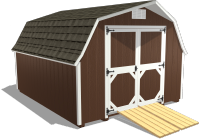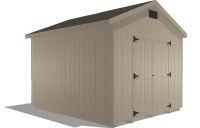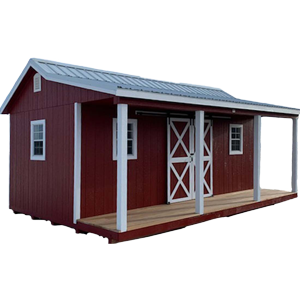Smart Greenhouse Pest Control: How to Identify, Prevent, and Manage Infestations
by Dakota Storage Buildings, on December 02, 2024

Every gardener dreams of a thriving greenhouse, but pests are one of the biggest threats to a healthy growing environment. These tiny intruders can cause significant damage to plants, stunt their growth, and even spread diseases that can devastate an entire crop. Without implementing effective greenhouse pest control, infestations can quickly spiral out of control, leading to increased maintenance costs and reduced yields. Let’s explore practical strategies to identify, control, and prevent pests in your greenhouse, so you can keep your plants healthy and productive.
How to Identify Common Greenhouse Pests
The first step to effectively control pests in your greenhouse is knowing what you are up against. There are several common greenhouse pests that can harm your plants, each leaving distinct signs of infestation:
Aphids: These small, soft-bodied insects can be green, yellow, or black. They feed on plant sap, causing leaves to curl and yellow. An unmistakable sign of aphids is a sticky substance called honeydew, which can lead to dark mold growth on plants.
Spider Mites: Tiny and often difficult to spot, spider mites are a red or yellowish color and tend to hide on the underside of leaves. Infestations can be identified by small yellow specks on the leaves and fine webbing between stems and leaves.

Whiteflies: These tiny, white-winged insects gather on the undersides of leaves. When disturbed, they flutter up in a small cloud. Whiteflies damage plants by sucking out sap, causing leaves to yellow, and a general decline in plant health.
Fungus Gnats: Adult fungus gnats resemble tiny black flies, while their larvae feed on the roots of plants. Infestations can be spotted by checking for small flying insects around the soil or noticing plants wilting despite proper watering.
Keeping a pest identification guide on hand or using a mobile app can help you quickly identify pests and respond promptly to infestations.
Natural Greenhouse Pest Control Methods
When it comes to controlling pests, natural methods are often preferred as they are safe for both plants and the environment. These methods reduce the risk of introducing harmful chemicals into your greenhouse and help maintain a balanced ecosystem where beneficial insects can thrive. Natural pest control solutions are also ideal for organic gardening with a greenhouse and can often be just as effective when used consistently. Here are some natural solutions you can try:
Beneficial Insects: Introducing natural predators like ladybugs, predatory mites, or parasitic wasps can help control pest populations. These insects feed on pests like aphids and spider mites, keeping them in check without harming your plants.
Neem Oil & Insecticidal Soap: Neem oil and insecticidal soaps repel pests like aphids, whiteflies, and spider mites. These options disrupt pests’ life cycles without the use of harsh chemicals. They can be sprayed directly onto plants and are safe for most crops.

Homemade Sprays: For a DIY approach, consider mixing a homemade insecticide using common household ingredients. A simple garlic or chili spray can deter pests, while a mixture of dish soap and water can suffocate soft-bodied pests like aphids.
Companion Planting: Planting certain crops together can naturally deter pests. For example, marigolds can repel aphids, while basil can help keep whiteflies at bay.
Traps: Sticky traps can be placed throughout the greenhouse to catch flying insects like whiteflies and fungus gnats, helping to monitor and reduce their numbers.
The Right Way to Use Chemical Solutions Safely
Natural methods may not always be sufficient to control severe infestations, and chemical treatments might become necessary. When using chemical solutions like insecticides and fungicides, it is crucial to choose products specifically labeled for greenhouse use that are targeted to the pests you are dealing with. These products can be highly effective for managing large pest populations, but using them safely is essential to avoid harming plants or beneficial insects.
Always follow the recommended dosage and frequency instructions carefully to ensure a safe application. Misusing chemicals can make the environment in your greenhouse toxic or damage your plants. Integrated Pest Management (IPM) is a helpful strategy when using chemicals. It emphasizes minimizing chemical use by combining various greenhouse pest control methods. This could involve rotating insecticides to prevent pests from building resistance and alternating between chemical and natural treatments. By rotating treatments and using them sparingly, you can reduce the need for multiple chemical applications while maintaining an effective pest control strategy.
5 Simple Steps to Keep Pests at Bay
Prevention is the key to maintaining a healthy, pest-free greenhouse. By taking a proactive approach, you can reduce the risk of infestations and protect your plants. Here are a few simple ways you can safeguard your plants from pests:
- Maintain Cleanliness: Regularly clean your greenhouse by removing dead plant matter, fallen leaves, and other debris where pests can hide. Keeping the space clean helps reduce the number of pest habitats.
- Proper Ventilation: Ensure proper airflow by using ventilation systems like roof vents or exhaust fans. Pests thrive in hot, humid environments, so regulating temperature and humidity levels can help reduce infestations.
- Regular Inspections: Conduct frequent plant inspections, focusing on both leaves and soil, to catch early signs of infestation. The sooner you spot a problem, the easier it will be to control.
- Quarantine New Plants: Before introducing new plants to your greenhouse, keep them isolated for a couple of weeks to ensure they are not harboring pests.
- Install Mesh Screens: Prevent pests from entering your greenhouse by installing mesh screens over windows and vents. Sealing any gaps in the structure will also help keep pests out.
How to Monitor and Manage Greenhouse Infestations
Even with preventive measures in place, it is crucial to continuously monitor pest levels and take quick action if an infestation occurs. Sticky traps are a useful tool for tracking pest activity around the greenhouse, while regular scouting — such as inspecting the undersides of leaves and soil — helps catch early signs of infestation. If you find pests, you must isolate the affected plants immediately to prevent the problem from spreading to healthier plants.

Swiftly treating is key when dealing with an active infestation. Whether you choose natural or chemical pest control methods, addressing the issue quickly and thoroughly will help minimize damage. After treatment, ongoing monitoring is crucial. Regularly assess the effectiveness of your greenhouse pest control efforts and make necessary adjustments to ensure that the greenhouse remains a healthy, pest-free environment. Continued vigilance is the best way to maintain productive plants and prevent future outbreaks.
Protect Your Greenhouse for Healthier Plants
Maintaining a pest-free greenhouse requires a combination of proactive prevention, effective identification, and targeted control methods. By implementing these strategies — whether natural or chemical — greenhouse owners can keep their plants healthy, reduce damage, and save time on pest management. Remember, a healthy greenhouse is one where pests are kept in check, ensuring strong plant growth and bountiful harvests. Start putting these practices into action today to maintain a thriving greenhouse environment.
If you are looking to start gardening with a greenhouse, explore our range of high-quality stock greenhouses designed to help you create the perfect growing space.

























